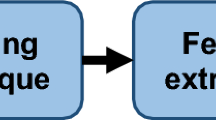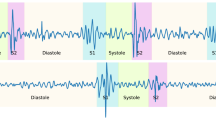Abstract
With the development of medical technology, many diseases can be cured. However, the mortality rate of cardiovascular disease is still high and showing an upward trend. Reducing the mortality of such diseases is one of the difficulties that modern medicine needs to overcome. Heart sound auscultation is one of the most basic detection methods for cardiovascular disease, but it is more difficult for inexperienced medical staff. Therefore, it’s urgent to develop assistive technology to assist heart sound auscultation.
According to previous works [1,2,3,4], it was concluded that deep learning has a notable effect on heart disease detection. The aim of this study is to develop a detection system to assist heart sound auscultation. Firstly, in the pre-experiment by debugging the batch size of CNN model, we determined that the accuracy of the model is the highest with the batch size of 256, which is 93.07%. Then, we used, a combined CNN and Long Short-Term Memory (LSTM) neural network model for heart sound detection, and obtained an accuracy of 91.06%.
Access this chapter
Tax calculation will be finalised at checkout
Purchases are for personal use only
Similar content being viewed by others
References
Rubin, J., Abreu, R., Ganguli, A., et al.: Recognizing abnormal heart sounds using deep learning. arXiv preprint arXiv:1707.04642 (2017)
Potes, C., Parvaneh, S., Rahman, A., et al.: Ensemble of feature-based and deep learning-based classifiers for detection of abnormal heart sounds. In: 2016 Computing in Cardiology Conference (CinC), pp. 621–624. IEEE (2016)
Nirschl, J.J., Janowczyk, A., Peyster, E.G., et al.: A deep-learning classifier identifies patients with clinical heart failure using whole-slide images of H&E tissue. PLoS ONE 13(4), e0192726 (2018)
Ryu, H., Park, J., Shin, H.: Classification of heart sound recordings using convolution neural network. In: 2016 Computing in Cardiology Conference (CinC), pp. 1153–1156. IEEE (2016)
Mendis, S., Puska, P., Norrving, B.: Global Atlas on Cardiovascular Disease Prevention and Control. World Health Organization in collaboration with the World Heart Federation and the World Stroke Organization, pp. 3–18 (2011)
Naghavi, M., et al.: Global, regional, and national age-sex specific all-cause and cause-specific mortality for 240 causes of death, 1990-2013: a systematic analysis for the Global Burden of Disease Study 2013. Lancet 385(9963), 117–171 (2015)
Wang, H., et al.: Global, regional, and national life expectancy, all-cause mortality, and cause-specific mortality for 249 causes of death, 1980-2015: a systematic analysis for the Global Burden of Disease Study 2015. Lancet 388(10053), 1459–1544 (2016)
McGill, H.C., McMahan, C.A., Gidding, S.S.: Preventing heart disease in the 21st century: implications of the Pathobiological Determinants of Atherosclerosis in Youth (PDAY) study. Circulation 117(9), 1216–1227 (2008)
Luisada, A.A., Liu, C.K., Aravanis, C., Testelli, M., Morris, J.: On the mechanism of production of the heart sounds. Am. Heart J. 55, 383–399 (1958)
Chen, T.-E., et al.: S1 and S2 heart sound recognition using deep neural networks. IEEE Trans. Biomed. Eng. 64(2), 372–380 (2016)
Chen, L., et al.: The diagnosis for the extrasystole heart sound signals based on the deep learning. J. Med. Imaging Health Inform. 8(5), 959–968 (2018)
Varghees, V.N., Ramachandran, K.I.: Effective heart sound segmentation and murmur classification using empirical wavelet transform and instantaneous phase for electronic stethoscope. IEEE Sens. J. 17(12), 3861–3872 (2017)
Liu, C., et al.: An open access database for the evaluation of heart sound algorithms. Physiol. Meas. 37(9), 2181 (2016)
Convolutional Neural Networks (LeNet) - DeepLearning 0.1 documentation. DeepLearning 0.1. LISA Lab, 31 August 2013
Convolutional Neural Network, 16 September 2014
van den Oord, A., Dieleman, S., Schrauwen, B.: Deep content-based music recommendation (PDF). Burges, C.J.C., Bottou, L., Welling, M., Ghahramani, Z., Weinberger, K.Q. (eds.) Curran Associates, Inc. pp. 2643–2651, 01 January 2013
Collobert, R., Weston, J.: A unified architecture for natural language processing: deep neural networks with multitask learning. In: Proceedings of the 25th International Conference on Machine Learning. ICML 2008, pp. 160–167. ACM, New York, 01 January 2008. https://doi.org/10.1145/1390156.1390177. ISBN 978-1-60558-205-4
Kingma, D., Ba, J.: Adam: a method for stochastic optimization. arXiv preprint arXiv:14126980 (2014)
Srivastava, N., Hinton, G.E., Krizhevsky, A., Sutskever, I., Salakhutdinov, R.: Dropout: a simple way to prevent neural networks from overfitting. J. Mach. Learn. Res. 15(1), 1929–1958 (2014)
Hochreiter, S., Schmidhuber, J.: Long short-term memory. Neural Comput. 9(8), 1735–1780 (1997). https://doi.org/10.1162/neco.1997.9.8.1735. PMID 9377276
Author information
Authors and Affiliations
Corresponding authors
Editor information
Editors and Affiliations
Rights and permissions
Copyright information
© 2020 Springer Nature Switzerland AG
About this paper
Cite this paper
Huai, X., Panote, S., Choi, D., Kuwahara, N. (2020). Heart Sound Recognition Technology Based on Deep Learning. In: Duffy, V. (eds) Digital Human Modeling and Applications in Health, Safety, Ergonomics and Risk Management. Posture, Motion and Health. HCII 2020. Lecture Notes in Computer Science(), vol 12198. Springer, Cham. https://doi.org/10.1007/978-3-030-49904-4_36
Download citation
DOI: https://doi.org/10.1007/978-3-030-49904-4_36
Published:
Publisher Name: Springer, Cham
Print ISBN: 978-3-030-49903-7
Online ISBN: 978-3-030-49904-4
eBook Packages: Computer ScienceComputer Science (R0)




